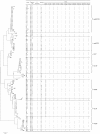Mobile genetic elements provide evidence for a bovine origin of clonal complex 17 of Streptococcus agalactiae
- PMID: 17526784
- PMCID: PMC1932819
- DOI: 10.1128/AEM.02604-06
Mobile genetic elements provide evidence for a bovine origin of clonal complex 17 of Streptococcus agalactiae
Abstract
We sought an explanation for epidemiological changes in Streptococcus agalactiae infections by investigating the link between ecological niches of the bacterium by determining the prevalence of 11 mobile genetic elements. The prevalence of nine of these elements differed significantly according to the human or bovine origin of the isolate. Correlating this distribution with the phylogeny obtained by multilocus sequence analysis, we observed that human isolates harboring GBSi1, a clear marker of the bovine niche, clustered in clonal complex 17. Our results are thus consistent with the emergence of this virulent human clone from a bovine ancestor.
Figures



References
-
- Bidet, P., N. Brahimi, C. Chalas, Y. Aujard, and E. Bingen. 2003. Molecular characterization of serotype III group B-streptococcus isolates causing neonatal meningitis. J. Infect. Dis. 188:1132-1137. - PubMed
-
- Brochet, M., E. Couve, M. Zouine, T. Vallaeys, C. Rusniok, M. C. Lamy, C. Buchrieser, P. Trieu-Cuot, F. Kunst, C. Poyart, and P. Glaser. 2006. Genomic diversity and evolution within the species Streptococcus agalactiae. Microbes Infect. 8:1227-1243. - PubMed
MeSH terms
LinkOut - more resources
Full Text Sources
Medical

